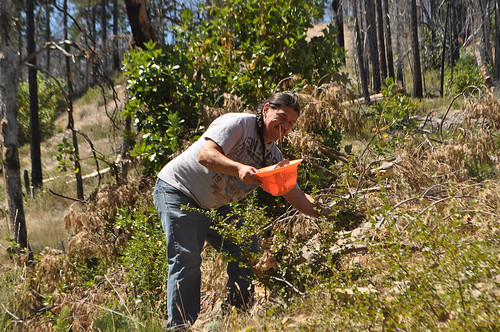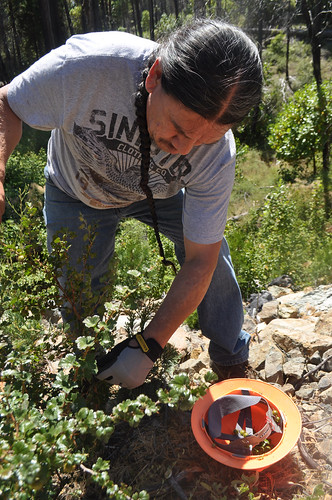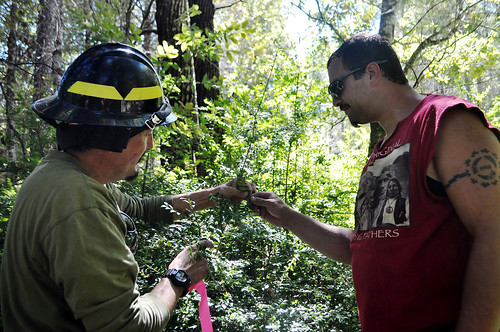
Ron Reed of the Karuk Food Crew collects gooseberries. Photo credit: Colleen Rossier

Ron Reed of the Karuk Food Crew collects gooseberries. Photo credit: Colleen Rossier
The Karuk and Yurok Tribes traditionally managed entire watersheds and ecosystems on their ancestral lands to meet their dietary, cultural and spiritual needs. The Tribes are now working with University of California -Berkeley, University of California -Davis, the U.S. Forest Service and other agencies to reestablish the once rich and bio-diverse ecology of their ancestral homeland forests and waterways using traditional agroforestry management systems.
“By putting fire back on the landscape, we intend to restore the currently wildfire-prone food desert into a healthy, bio-diverse, fruit, nut and wildlife-rich forest,” said Karuk Department of Natural Resources Director Leaf Hillman.Yurok Heritage Preservation Officer Bob McConnell added, “Wise use of fire will enable both the Yurok and the Karuk Tribes to incorporate many other traditional management techniques into forest restoration as well. Once the forests are more open, local practitioners will be better able to restore hundreds of smaller patches across the forest currently too overgrown to access.”
The traditional land management systems of the Karuk and Yurok Tribes include forest-grown foods, such as acorns, pine nuts, huckleberries, hazelnuts, raspberries, deer, elk and mushrooms, as well as salmon and eels that require cool, spring-fed water. While these foods are still present, they are scarce compared to historic levels. This year, for example, there may not be enough acorns for annual ceremonies.
Traditional land management systems incorporated a range of burns at different intensities and frequencies, as well as a variety of pruning, gathering and hunting techniques.
“We’ve been given clear instructions for caring for our relations; the earth, fire, water, the sky,” said Lisa Hillman, Karuk Tribe’s Food Security Coordinator. “These are rules to which we as a People must adhere in order to maintain the balance necessary to ‘fix the world’ each year.”
It is important to note that the Tribes manage these forests as a cultural and spiritual responsibility to their homeland, its plants, animals and people, and their Creator. Thus, their traditional management systems intend to enhance plant and animal populations for future generations rather than exploit these precious natural resources for personal economic gain.
This is one example of how many American Indian and Islander communities manage complex systems to meet their physical, cultural and spiritual needs. Indigenous, traditional ecological knowledge comprises a much broader set of practices than agroforestry, but can improve and inform agroforestry practices and land management both on and off of tribal lands.
Traditional ecological knowledge, also called native knowledge, can be defined as the knowledge, practices and beliefs about the relationship of living beings with one another and with their environment. It is connected to a place, people, culture, spiritual beliefs and responsibility to family and community for the future. This knowledge must be practiced and adapted to stay alive and current.

Jesse Goodwin of the Karuk Food Crew and Frank Lake of the US Forest Service examine evergreen huckleberries. Photo credit: Colleen Rossier
With the recent publication of an Agroforestry Note: Indigenous Traditional Ecological Knowledge in Agroforestry, the USDA National Agroforestry Center intends to:
1. Acknowledge indigenous traditional ecological knowledge of agroforestry systems,
2. Express a desire to learn from tribal communities that are currently practicing agroforestry; and
3. Support others interested in practicing agroforestry.
This publication describes how some indigenous communities are applying traditional ecological knowledge in their agroforestry systems. Many agroforestry practitioners are learning from these complex systems.
No comments:
Post a Comment
Note: Only a member of this blog may post a comment.